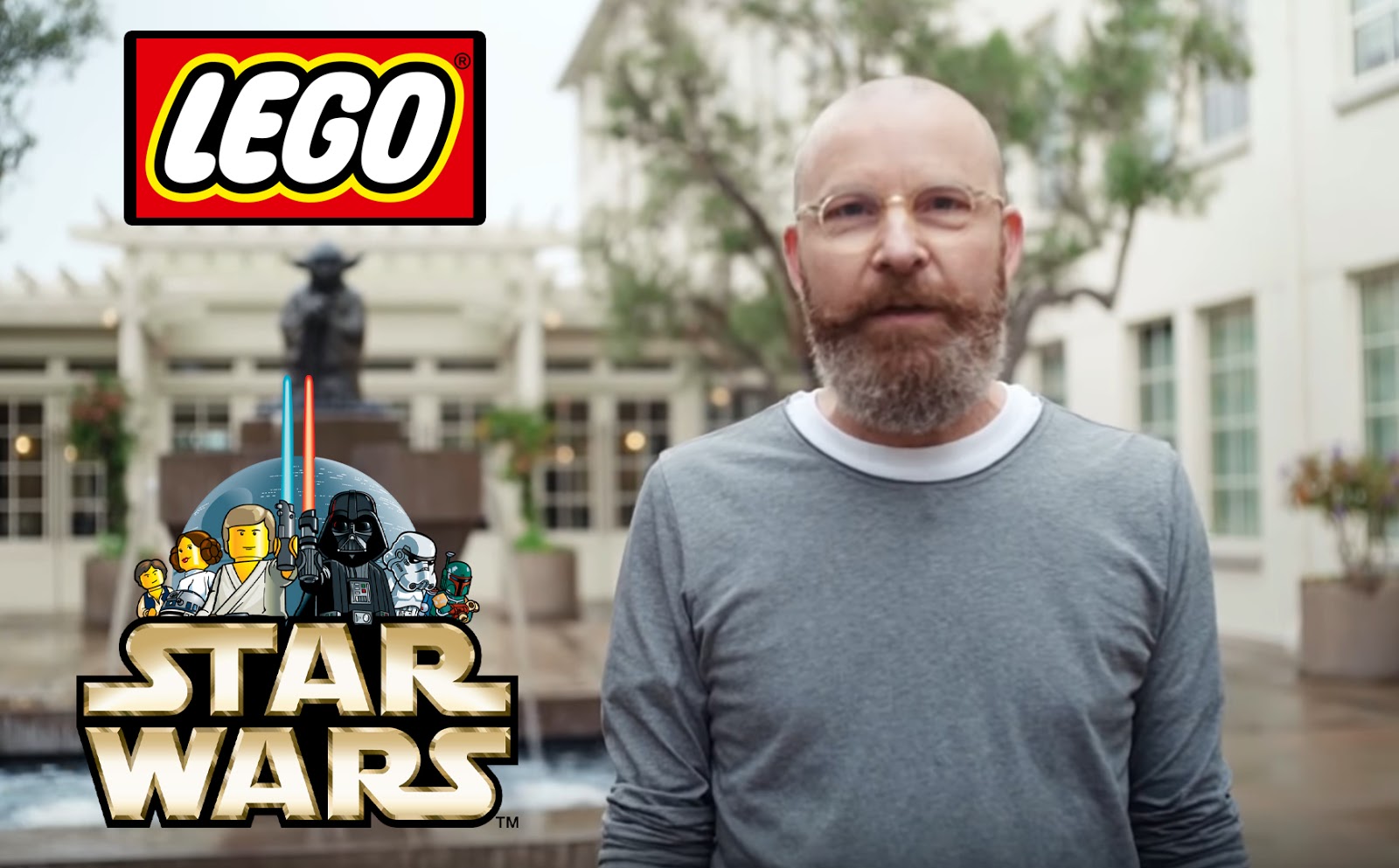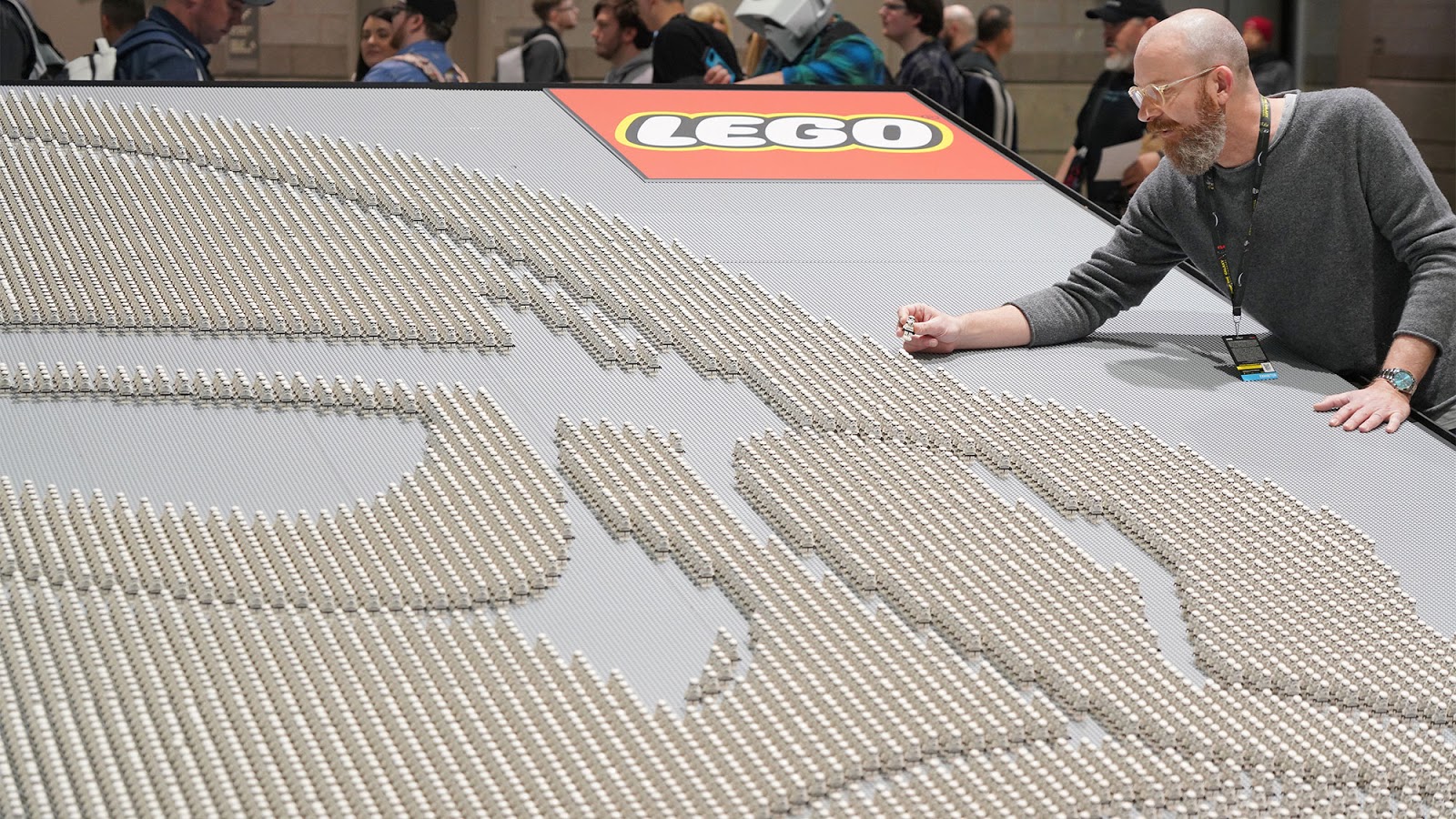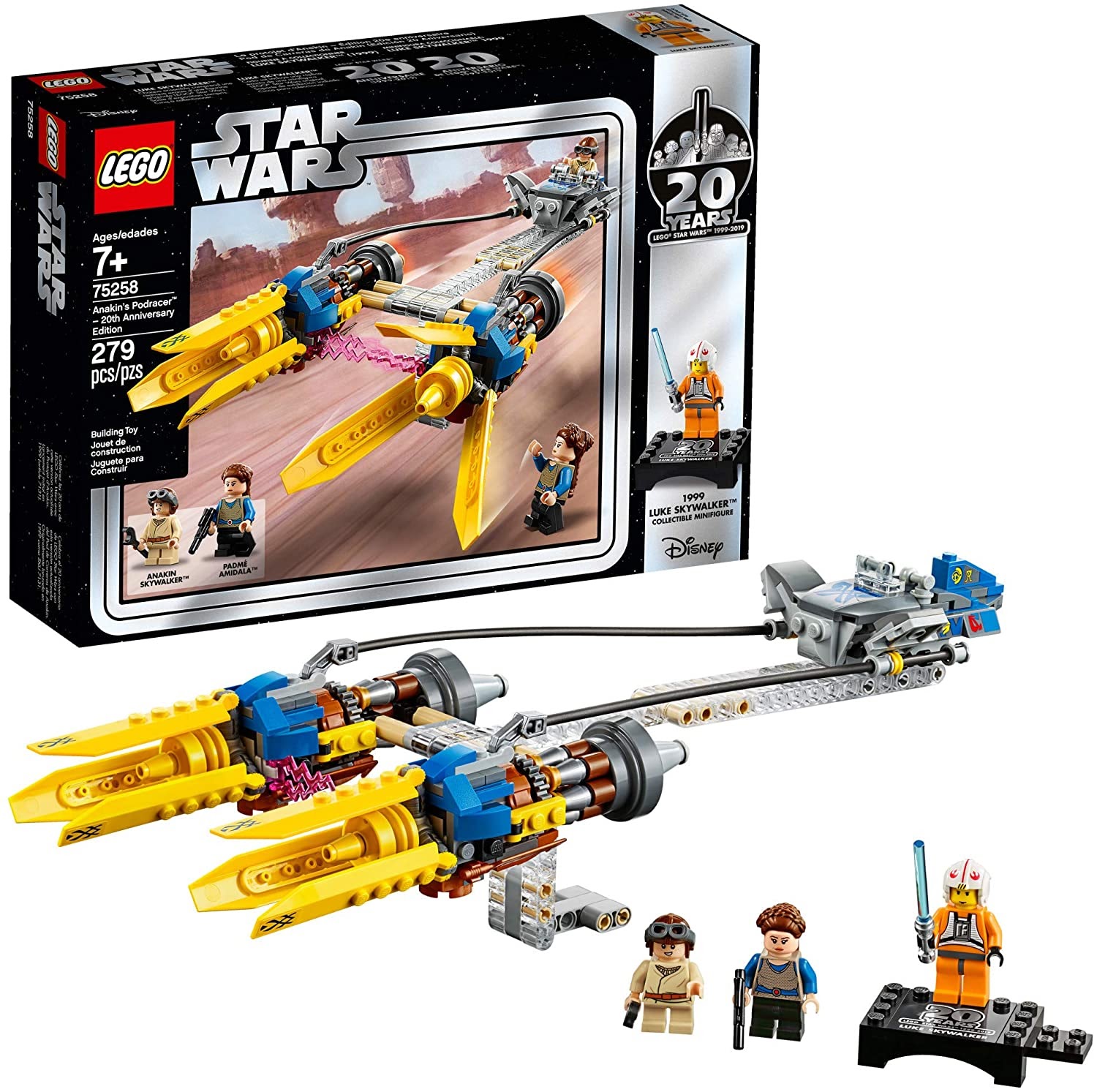LEGO designer Jens Kronvold Frederiksen has been working on the internationally popular toy brand’s Star Wars line since pretty much the very beginning, and he recently celebrated his twentieth anniversary at his company alongside the twentieth anniversary of the LEGO Star Wars license.
This week the FOX Network’s reality TV competition series LEGO Masters is airing its Star Wars-themed episode, and in celebration of the show’s visit to A Galaxy Far, Far Away I spoke on the phone with Jens Kronvold Frederiksen about his history at LEGO, his working relationship with Lucasfilm, and his contribution to creating one of the largest commercially-available LEGO building sets of all time– the Ultimate Collector Series Millennium Falcon.
Mike Celestino, Laughing Place: Tell me about your personal history with LEGO growing up, and were you a Star Wars fan before working for LEGO?
Jens Kronvold Frederiksen: Well, LEGO has always been a big part of my life, because I think more than anywhere else, in Denmark every child plays with LEGO. Especially when I was a kid, there wasn’t that much to choose from. LEGO was really the thing, so I played with LEGO a lot.
Regarding Star Wars, that’s another story. As a kid, I actually didn’t see the movies, but I knew Star Wars from the comics. So I knew all about the stories and so on, and I was also a big fan of that. That’s also been a big thing for me, and I have to say later at LEGO when I saw that Star Wars was going to [become licensed], it was really a great pleasure for me.
LP: How did you become a LEGO designer?
Frederiksen: I started at LEGO back in 1998. I got a freelance job there at that time, and I got it because of my hobby or interest, which is scale modeling– something totally different because what I’m doing is mainly [creating] small plastic models you put together. Because of that, I was pretty good at sculpting as well, so I was hired as a freelance designer, creating prototypes for new elements. But before I even started, I saw that there was an open position for a model designer. I applied for the job and I got it. So that was how my career started at LEGO.
At the time when I started, I remember my first day at LEGO, one of the first things I saw when I entered the studio was a design area of prototypes for Star Wars, so it was already started at that time. I was super excited about that.
LP: What were some of your initial challenges when you first approached the Star Wars IP as a LEGO designer?
Frederiksen: Phew, that’s a long story. At that time I was a model designer, so I wasn’t really deeply involved in the big discussions that were going on. There were some big decisions to be made, because it was a new thing. First of all, it was one of the first IP product lines for LEGO. And then also, with something like Star Wars, it’s a fantasy world, but still it’s about weapons, so there was really some discussion about how to do it. But at LEGO, right from the beginning we were thinking about one thing [that] was really important to us: the humor. It’s always part of any product line at LEGO, and we definitely also wanted to include that in the LEGO Star Wars universe.
The Podracers– I remember that as one of the first new challenges regarding the models. We have this weird vehicle, and of course we hadn’t seen the movie. We got some drawings– Doug Chiang’s concept art– that we received as the first reference. There are two engines that are hovering in the air and a little cockpit in the back; how are we going to do that as a toy so that a kid can actually play with it? I would say that was one of the most challenging things in the beginning.
Then there’s the whole thing about the minifigures, where we needed to decide how we were going to create all the characters and aliens that are seen in the Star Wars universe. And that’s when we decided that some characters, if they’re human-like, then we would normally use the regular minifigure head and just decorate the character’s [face] on it. But if it’s alien, then we would do the sculpted heads. Actually, the first-ever sculpted head for the minifigure was Jar-Jar Binks.
LP: More recently, what has your work been like on the LEGO Star Wars line?
Frederiksen: As it is today, I’m not designing models myself. We have a design team that [is] doing the design work, and then I’m overseeing it. But still I’m heavily involved, because very often my favorite moments at work [are] if there’s a designer that’s dealing with a problem in a model he can’t solve, and then [I] just go through the drawers, grab the right bricks and show him how it could be done. In that regard, I really enjoy the building phase and the design phase of the models. But I’m not creating the models myself anymore.
LP: I want to ask you about the Ultimate Collector Series Millennium Falcon, which is one of my favorite LEGO Star Wars sets.
Frederiksen: Do you have the new or the old one?
LP: I have the newer version, but can you tell me how the original model came to be in 2007 and how it was updated a couple years ago?
Frederiksen: It’s a funny story, because as you might know, I designed the first one. It was one I created, and it actually all started as a side project that I was doing in my spare time. I remember at that time we had launched a Millennium Falcon in play-theme scale, and [fans] were complaining about it because it was impossible to fit four minifigures into the cockpit like in the movie. That was really annoying me a lot, and I was thinking, ‘It must be possible to design a ship that is more in true minifigure scale.’
Then I took some drawings and blew them up on the wall and I started building it. Some people came to me and asked what that was about, and I said it was just a side project for fun. But they asked, ‘Why don’t we make that as a product?’ At that time, we had never ever created a product in that size before. Everything was from scratch; we had to develop completely new packaging. It took a year to create the building instructions– one person working constantly on it for a year, just to explain how big a thing it was to create a set of that size. There [were] also concerns internally about a set that expensive. Would people really buy it? But we launched it, and as you know it ended up being a huge success.
Then later, after some years, we could see that there was a high demand [for it]. A lot of people wanted it back. We thought, ‘Yeah, let’s do that,’ but we’d also seen a lot of people complaining about the old version that I did. One of the things was the lack of interior. [That] was something a lot of people [were] really missing. So we thought about that, and we were talking about putting full interiors in it, but we could also see that that would [make the set contain] ten thousand pieces or something, and it would be super super expensive. So we decided instead [to create] the most important areas, and then small panels you could lift off. By doing that, you still have a model that looks nice with all the main parts on the top, but then with small holes where you can look into the interior. And then Hans [Burkhard Schlömer], the designer, he made a lot of other improvements to fix my original model.
LP: A lot of different Star Wars vehicles and locations have been re-created multiple times across the two-decade history of LEGO Star Wars. What are the goals in updating the models each time they get remade?
Frederiksen: As you say, we are doing the same ships and vehicles several times, and that’s because there are some classics– there are some ships that just are always popular. So when we are making a new version of something we have done before, the very first thing we do is– like with the Millennium Falcon— we look at consumer feedback. What had the fans’ reaction been to the previous model? Were there things they thought didn’t work or could be improved or were there things they really liked? And then we’re using that as part of the brief for the designer of the new version of it.
We also always start totally from scratch on a model, and that’s because we know there are people that might have a previous version of it, so we want to bring something new. We also want to try and include new features or functions, new minifigures, and so on, to make it look new and fresh. And then also, in the meantime we have usually [molded] a lot of new elements– LEGO pieces that make us capable of making a better model than the previous one.
LP: What has your working relationship with Lucasfilm been like? What is the back-and-forth like for the various LEGO Star Wars models? Are they giving you a lot of notes?
Frederiksen: As you know, it’s [been] a long relationship. And it’s actually funny, because one of the people there at Lucas Licensing, he’s just had his twentieth anniversary at Lucasfilm, and I had the same at LEGO, so we’ve been working together for more than twenty years now. So we really know each other, and the cool thing about that is also that they have a very good understanding of what a good LEGO toy is.
Usually, I would say, even though sometimes we are simplifying things or we are adding details or features or functions that [are] not present in the movies, they are allowing us to do things that help make a better toy for kids. There’s a huge flexibility there. Another thing is something that they had to learn in the beginning [about] what a LEGO product is. For instance, if you have a completely white ship, inside of it would be a lot of color elements hidden to make the building experience better for a child or for a fan. That was something that we had to explain to Lucas. That’s how a LEGO model is.
We are getting comments. They are of course approving everything, from models to graphic design to minifigures and so on, but we have a really really good relationship and it’s usually just small comments they have for our work.
LP: Last year you visited Lucasfilm headquarters in San Francisco and met with executive creative director Doug Chiang in celebration of the 20th anniversary of LEGO Star Wars. What was that like?
Frederiksen: That was really a great experience. And Doug Chiang, he’s a really nice guy. I’ve met him several times. We actually also worked together earlier [on LEGO Star Wars: The Freemaker Adventures], the TV show that we developed. That was actually based on concept art that was made by Doug Chiang. And it was based on our story, so it was really interesting. At that time, he also visited us in Billund, in Denmark at the LEGO headquarters.
[The Freemaker Adventures] was developed in cooperation together with Lucas/Disney, but it was LEGO’s story within the Star Wars universe. It was interesting, because it meant that we could make ships and things that had never been seen before, but it’s now canon. So that was super interesting to work with, to actually develop something brand new for Star Wars.
LP: And then you attended Star Wars Celebration in Chicago last year. Was that your first time at the event and do you hope to go again?
Frederiksen: It was my first Star Wars Celebration. I have to say it was really overwhelming. It was absolutely crazy; there were so many people there and it was really impressive. It was a great experience, being a Star Wars fan myself and being part of that celebration. We had our twentieth anniversary for LEGO Star Wars [there], which is a big thing and I’ve basically been working on it from the beginning. That was a great experience, and I bought I don’t know how much stuff– I was carrying a lot of bags home with all kinds of stuff for myself. [laughs] I hope it’s not going to be my last Star Wars Celebration.
LP: Lastly, I want to ask you about the Star Wars episode of LEGO Masters that’s airing in the US this week. I know you’re not involved in the making of the show, but do you have any thoughts about that series in general?
Frederiksen: I’ve seen some of it, and I understand that it’s a very popular show. It’s definitely easy to understand. I think it’s the essence of LEGO: showing the creativity and what you’re capable of doing with LEGO. Having an episode about LEGO Star Wars is going to be super exciting because some people think that when we’re doing [an] IP product line, it’s limiting the creativity. But here I think it’s really great to show that no, you can actually be really creative also within something like the LEGO Star Wars universe. There are no limits.
It’s the same thing when we have our people talking about kids that got this X-Wing or whatever model from LEGO Star Wars and took it apart and built their own ship. We’re clapping our hands; that’s really what we want. We want to stimulate kids’ creativity, so with a show like that, I just think it’s great. It’s also something that, from what I hear, brings families together and makes a lot of people want to play with their kids, which we know happens a lot with LEGO Star Wars. I think if we can stimulate that then the show has really done what it should.
https://www.youtube.com/watch?v=EdXZJ_kNQRo
The full audio version of this interview was included in last week’s episode of Laughing Place’s “Who’s the Bossk?” Star Wars podcast.





